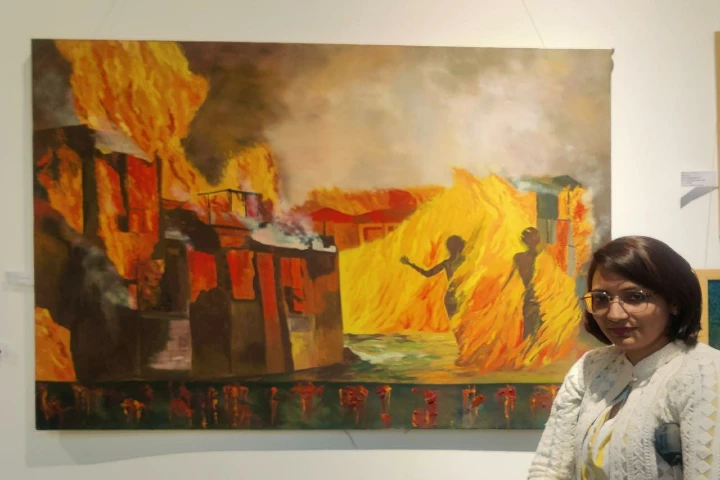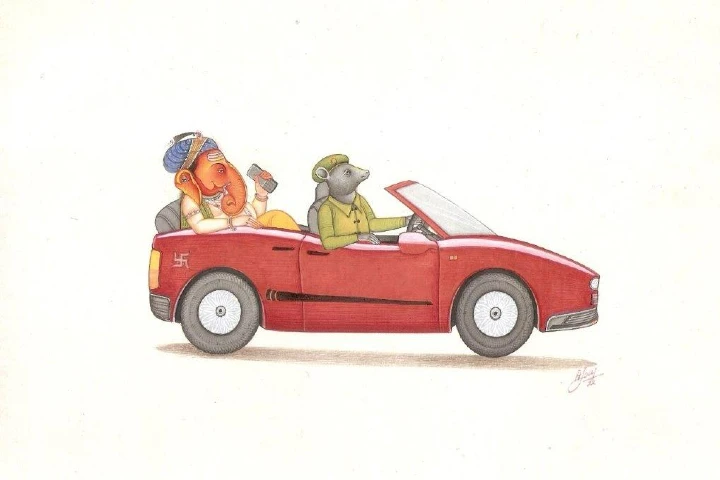

Artist Anjum Malik with her work 'The Burning Home'
In the ongoing group show “Beyond Limits-2022” organized by Family of Disabled, 56 artists using their creativity have skillfully highlighted diverse issues and subjects through their 95 artworks. Kudos to all these specially-abled artists who have proved that they are second to none when it comes to imagination, talent, originality and expertise.
Artists being part of the society are bound to be affected by what is happening around them. An example of this comes through in Delhi-based Anjum Malik’s “The Burning Home”. A hard-hitting work, its bright orange and red flames makes the viewer feel the intense heat and pain which victims of violence suffer when they and their homes are set on fire. The dab of red colour at the bottom symbolizing clotted blood has a chilling effect on the viewer.
Talking to India Narrative about the painting Malik said: “On reading about the atrocities faced by Rohingya Muslims in Myanmar, I was inspired to create this work. It represents not just their agony but that of all those victims of injustice and violence all over the world, irrespective of their faith or the region or creed they belong to.”


Taking cue from the contemporary, Rajasthan’s Ajay Kumar Garg series on Lord Ganesha, shows the God playing football, sitting in a pram holding a balloon, reading a newspaper, going round in a car driven by a mouse, and going to Kedarnath with his family. Though small in size, these works reflect the artist’s minute and detailed effort.
Two works by Mehtab Saifi of Delhi – “The Temple” and “Village of Ghats” – take the viewer straight to Banaras. Done on large canvases, both are suffused with details. In the first the flags on top of the temple, the reflection of the structures in the water, and people having a dip in the river, and the early morning sun rays lend a spiritual ambience to the work. The second one depicts old and relic structures on the river side showing how humans have been close to waterways since time immemorial.
Likewise, Rajasthan’s Rohit Vyas in “An Ancient Temple” also does well to bring out the effects of passage of time on a place of worship as portrayed through its weathered walls and worn-out stone steps.
Meghalaya’s Tribit Kumar Hajong exhibits his control on the medium in “Pathin Art” showing culture of his State, particularly of the rural areas. A close look of the man in the frame reveals that his nose is shaped in the form of a bovine while at one end of his instrument, children are playing. The entire life of the village is portrayed through him – women washing clothes, winnowing grain, carrying firewood and catching fish.
Everyday life is well illustrated by Punjab’s Hardeep Singh Kalsi in his works “Innocent Childhood” and “Elderly Punjabi Women Making Cotton Yarn”. The former shows children sitting in an open field engrossed in studies. Their attire, the bags, the mats on which they are seated, their bags and books all have life-like resemblance. Similarly, the latter has two women busy spinning cotton and their dress, footwear, forehead wrinkles, the setting of the house and the furniture, all look authentic.
It is worth spending time at this exhibition given the quality of paintings and sculptures exhibited.
(On view till December 11 at Arpana Art Gallery, Siri Institutional Area, New Delhi from 11 a.m. to 7 p.m.)
Prime Minister Narendra Modi on Tuesday held a telephonic conversation with Union Home Minister Amit…
Prime Minister Narendra Modi landed in Jeddah on Tuesday for a two-day State visit to…
Lauding the "deep connection" between the United States and India, US Vice President JD Vance…
Indian Minister of Power and Housing Affairs, Manohar Lal Khattar, visited the Arun-III Hydel Project,…
The body of the late Pope Francis will be transferred to St. Peter's Basilica on…
The case of Baloch human rights activist Dr Mahrang Baloch has been officially accepted for…